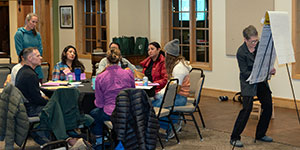Wyoming Residents Want Communities to Plan for Changes in Water Resources, UW Survey Shows
Published May 02, 2025

A new University of Wyoming survey reveals Wyoming residents overwhelmingly believe that changes in water resources are happening, and risks can be reduced with community response plans and statewide policies.
“This survey reveals some unexpected perspectives of Wyoming residents. We need to reorient to better serve them,” says Corrie Knapp, an associate professor in UW’s Haub School of Environment and Natural Resources who is one of the co-leaders of a new university Center for Rural Resilience and Innovation. “We hope this new center can meet emerging needs around water resources.”
The survey revealed that 82 percent of respondents agree that Wyoming is at risk of changing water resources, and 75 percent of respondents think it is wise and necessary to adapt to these water changes.
Respondents also believe that climate change is happening (86 percent), but they are split on the causes, with 47 percent saying that natural fluctuations in Earth’s temperatures are the cause and 39 percent saying that humans are the cause.
Results also show that respondents largely think their communities should plan for water changes (81 percent), yet only 38 percent of respondents say other members of their community believe that water changes are happening. Just under half of respondents say that people who are important to them believe we should plan for changing water resources.
“Wyoming residents underestimate others’ beliefs that changes in water resources are happening, and they underestimate others’ beliefs that we need to do something about it,” says Kristen Landreville, a researcher on the project who previously was on the faculty of UW’s Department of Communication and Journalism. “There is more support for community planning than Wyoming residents think.”
Landreville says this underestimation of community support for adaptation planning can lead to a “spiral of silence.”
“If we think that others hold a different opinion than us, or if we aren’t sure what others think, then we may not talk about these issues at all,” she says. “And that misses an important opportunity to collectively anticipate, address and plan for the problems that changing water resources creates for our state.”
Support for Community Plans But Uncertainty About Feasibility
About 43 percent of respondents expressed confidence in their ability to work together with their communities to plan and adapt to water changes. However, people felt less confident their communities had the knowledge (26 percent) and motivation (16 percent) to plan and adapt.
“Even though residents generally support community response plans to address changing water resources, they aren’t so sure about them being well-equipped,” Landreville says. “People are concerned about money and funding as well as technology, equipment and infrastructure, for example.”
Broad Support for Policy Measures to Address Changing Water Resources
Respondents were presented with 15 different policy options to address changing water resources in Wyoming and were asked to rate their agreement with each policy. Nine of the 15 policies had support greater than 50 percent of respondents.
The policies with the most support included a public information campaign about water conservation (74 percent), a state program to more efficiently use wastewater (74 percent) and a small financial incentive to residents who conserve water (66 percent). Other strongly supported policies dealt with proactive wildlife management policies, K-12 education efforts about water, and payment to Wyoming water rights holders to invest in water-efficient operations.
“We also see many residents saying these adaptation policies are worth the cost investment,” Landreville says.
Policies that did not receive much support were mandated water reductions for Wyoming water rights holders (31 percent) and cost increases of water to individuals and businesses (19.4 percent).
Survey Methodology
The statewide survey was conducted in June and July 2024 by UW’s Wyoming Survey and Analysis Center, yielding 500 responses from Wyoming residents who are enrolled in its WyoSpeaks panel. The panel was created via probabilistic sampling that comprised a random selection of Wyoming residents, which gives every person in Wyoming with internet access an equal probability of selection for the survey. The margin of error for the distribution of responses on any individual survey question is plus or minus 4.38 percentage points, with a 95 percent confidence interval.
Men and women from all age groups and all counties in Wyoming are proportionally represented in the survey data. The final survey data have been weighted to reflect the actual population distribution in Wyoming on sex, age, county of residence and education.
The full report, with an executive summary, methodological outline and complete survey results, can be found in WyoScholar at https://wyoscholar.uwyo.edu/items/bfa3bfce-040e-4db0-b85f-a55a03437b6f.
Visit WySEaSON at https://wyadapt.org/wyseason/apps/social-science/ for an interactive dashboard of survey results.
Funding is provided through National Science Foundation EPSCoR (Established Program to Stimulate Competitive Research) grant NSF OIA 2149105.

